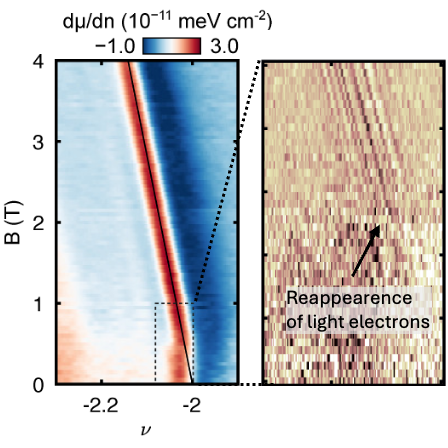Electrons play many roles in solid materials. When they are weakly bound and able to travel – i.e., mobile – they can enable electrical conduction. When they are bound, or “heavy,” they can act as insulators. However, in certain solid materials, this behavior can be markedly different, raising questions about how these different types of electrons interact.
In a study just published in Nature Physics, researchers working with Professor of Physics and Applied Physics Amir Yacoby at Harvard examined the interplay between both types of electrons in this material, shedding new light on how they may help form novel quantum states.
“Before our work, people could only ask ‘What is the overall ground state’?” said Andrew T. Pierce, one of the paper’s lead authors., Pierce, currently a fellow at Cornell University, was a graduate student in Yacoby’s lab when they began to study this question. What wasn’t clear was the true nature of these different states and how the separate light and heavy electrons joined forces to form them.
Additionally, because of the more obvious role of heavy electrons to drive insulators, light electrons have often been dismissed as “doing nothing” or “being spectators,” said Yonglong Xie, one of the paper’s lead authors. A former Harvard Quantum Initiative Prize postdoctoral fellow in Yacoby’s lab, Xie, now an assistant professor at Rice University, noted that the effect of these light electrons on the overall system was hard to detect.
The interplay between electrons with different masses is believed to drive intricate quantum phenomena. In the novel material known as magic-angle twisted trilayer graphene (MATTG), where three layers of graphene are stacked together with the middle sheet rotated slightly, electrons with small and large masses coexist. This material supports a plethora of exotic quantum phenomena including superconductivity (i.e. electrical conduction without heating), thereby providing a new setting to address this question.
To understand what was going on in these cases, the researchers used a specialized form of microscopy, known as scanning single-electron transistor (scanning SET), pioneered by Yacoby, to examine tiny “puddles” in the MATTG where electrons are trapped when the MATTG enters an insulating state. The scanning SET indicated that while the heavy electrons enable insulating states, the light electrons remain mobile, suggesting that they should participate in forming the novel states, including superconductivity.
“The heavy electrons form an insulator among themselves, creating the illusion of an overall insulating state, but in reality the light electrons remain free,” clarified Pierce. “This raises the possibility that the light electrons can mediate interactions between heavy electrons.”
This surprising finding underscores how complex the interplay between light and heavy electrons in MATTG can be, the researchers said. They suggested that exploring further methods of “tuning” the ratio of heavy and light electrons in two-dimensional materials will lead to exciting new discoveries. “The problem of coexisting light and heavy electrons in solids is a long-standing one, and we hope our scheme for disentangling their roles gives a new approach to these intriguing materials,” said Pierce.
The research was supported, in part, by the Army Research Office, the National Science Foundation, and the CIFAR Quantum Materials Program, and the Welch Foundation.
